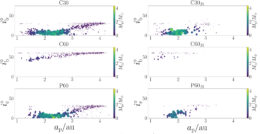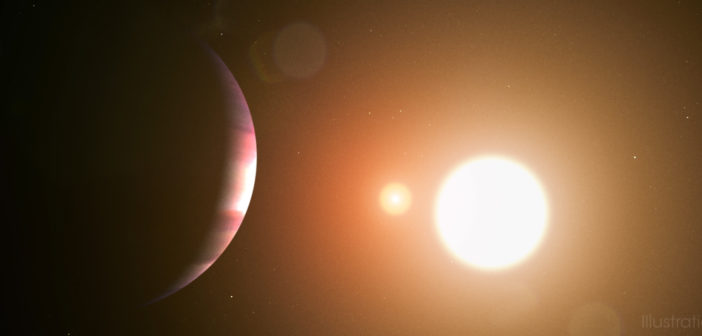Can planets form in a tilted disk around a pair of stars? New simulations explore what happens in off-kilter planetary systems.
Seeking Skewed Systems

Radio observations revealed that the young binary system L1551 NE has a misaligned disk. [Adapted from Takakuwa et al. 2017]
The lack of planets seen in highly misaligned orbits might mean these planets are rare, but it could also mean that these planets are simply difficult to detect. With misaligned circumbinary systems still hard to come by, we must turn to models to explore what happens in these systems — what determines whether a planet orbiting two stars does so in the same plane as the binary system, perpendicular to it, or somewhere in between?
Modeling Misalignment
Anna Childs and Rebecca Martin (University of Nevada, Las Vegas) approached this question by modeling how the eccentricity of a binary system and the initial tilt of the surrounding disk affect the final orbital parameters of a planetary system. Childs and Martin investigated binary systems with perfectly circular orbits (e=0) and disks inclined by 30 and 60 degrees, as well as binary systems with very elongated orbits (e=0.8) and disks tilted by 60 degrees. In each case, the team initiated their simulations late in the process of planet formation, when the planetary systems are mostly free of gas and contain a host of Moon- and Mars-sized planetesimals.

Simulation results at three points in time for a circular binary system with a 30° inclined disk (top) and an eccentric binary system with a 60° inclined disk (bottom). Click to enlarge. [Childs & Martin 2022]
Giant Planets in the Mix

Degree of misalignment from a coplanar or polar orbit for simulations without (left) or with (right) giant planets introduced. The simulations shown are circular and inclined by 30 degrees (C30), circular and inclined by 60 degrees (C60), and eccentric and inclined by 60 degrees (P60). The symbol size and color varies with the planet mass. Click to enlarge. [Adapted from Childs & Martin 2022]
Notably, almost all of the simulated planets fell into coplanar or perpendicular orbits. If future observations reveal planets at intermediate inclinations, this might mean that those planets followed a different formation pathway from the one explored in this study. Hopefully, it’s just a matter of time before we detect circumbinary planets in misaligned orbits and put our theories to the test!
Citation
“Misalignment of Terrestrial Circumbinary Planets as an Indicator of Their Formation Mechanism,” Anna C. Childs and Rebecca G. Martin 2022 ApJL 927 L7. doi:10.3847/2041-8213/ac574f

